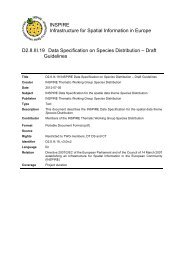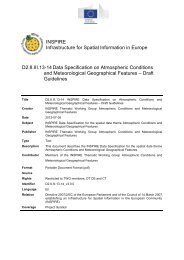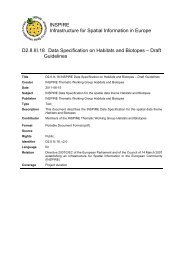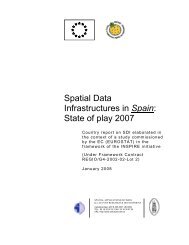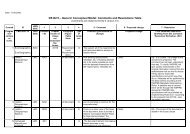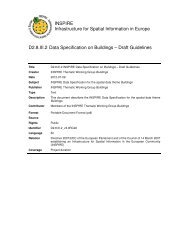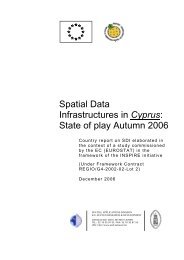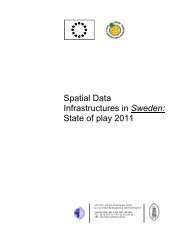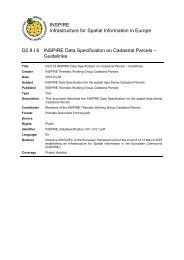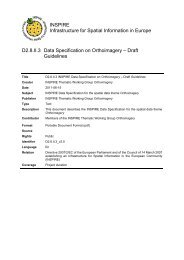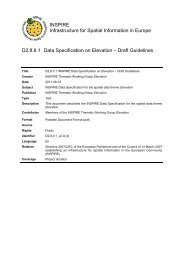Production and Industrial Facilities - INSPIRE - Europa
Production and Industrial Facilities - INSPIRE - Europa
Production and Industrial Facilities - INSPIRE - Europa
Create successful ePaper yourself
Turn your PDF publications into a flip-book with our unique Google optimized e-Paper software.
<strong>INSPIRE</strong> Reference: D2.8.III.8_v2.0(.0)<br />
TWG-PF Data Specification on <strong>Production</strong> <strong>and</strong><br />
<strong>Industrial</strong> <strong>Facilities</strong><br />
2011-06-15 Page LI<br />
Description: NOTE 1 The spatial object, referenced by the address, is defined as the<br />
"addressable object". The addressable object is not within the application schema,<br />
but it is possible to represent the address' reference to a cadastral parcel or a<br />
building through associations. It should, however, be noted that in different countries<br />
<strong>and</strong> regions, different traditions <strong>and</strong>/or regulations determine which object types<br />
should be regarded as addressable objects.<br />
5.2.2.5.4. Identifier<br />
Identifier<br />
NOTE 2 In most situations the addressable objects are current, real world objects.<br />
However, addresses may also reference objects which are planned, under<br />
construction or even historical.<br />
NOTE 3 Apart from the identification of the addressable objects (like e.g. buildings),<br />
addresses are very often used by a large number of other applications to identify<br />
object types e.g. statistics of the citizens living in the building, for taxation of the<br />
business entities that occupy the building, <strong>and</strong> the utility installations.<br />
NOTE 4 For different purposes, the identification of an address can be represented<br />
in different ways (see example 3).<br />
EXAMPLE 1 A property can e.g., be a plot of l<strong>and</strong>, building, part of building, way of<br />
access or other construction,<br />
EXAMPLE 2 In the Netherl<strong>and</strong>s the primary addressable objects are buildings <strong>and</strong><br />
dwellings which may include parts of buildings, mooring places or places for the<br />
permanent placement of trailers (mobile homes), in the UK it is the lowest level of<br />
unit for the delivery of services, in the Czech Republic it is buildings <strong>and</strong> entrance<br />
doors.<br />
EXAMPLE 3 Addresses can be represented differently. In a human readable form an<br />
address in Spain <strong>and</strong> an address in Denmark could be represented like this: "Calle<br />
Mayor, 13, Cortijo del Marqués, 41037 Écija, Sevilla, España" or "Wildersgade 60A,<br />
st. th, 1408 Copenhagen K., Denmark".<br />
Package: <strong>INSPIRE</strong> Consolidated UML Model::Generic Conceptual Model::Base Types<br />
[Include reference to the document that includes the package, e.g. <strong>INSPIRE</strong> data<br />
specification, ISO st<strong>and</strong>ard or the GCM]<br />
Definition: External unique object identifier published by the responsible body, which may be<br />
used by external applications to reference the spatial object.<br />
Description: NOTE1 External object identifiers are distinct from thematic object identifiers.<br />
5.2.2.5.5.<br />
NOTE 2 The voidable version identifier attribute is not part of the unique identifier of<br />
a spatial object <strong>and</strong> may be used to distinguish two versions of the same spatial<br />
object.<br />
NOTE 3 The unique identifier will not change during the life-time of a spatial object.




